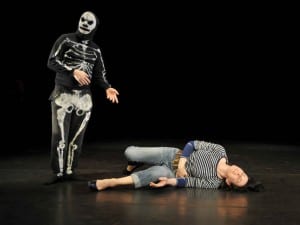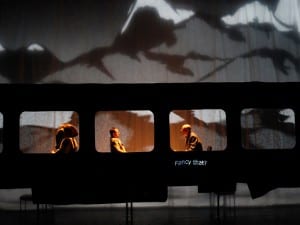You Imagine What You Desire is a fitting title for Sydney’s 19th Biennale running until 9 June. Spread across five venues – which span the width of the city and includes an island in the middle of Sydney Harbour – the programme forces audiences to slowly absorb the ideas, beauty and creative energy of each venue’s work. This year’s Biennale doesn’t have a didactic theme but simply aims to activate audiences’ desires.
Artistic Director of the Biennale Juliana Engberg said she was guided by the feeling of each space during curation. This influence is most obvious on the rugged and strange Cockatoo Island. Engberg’s presentation of work in this former prison and shipping dock reiterates her description of it: a fantasy location, a fun-park; a utopia perhaps, and with it, a dystopia: a relic – a land of strangeness. In the middle of this ‘strange land’ lies a derelict jumbo-hanger sized turbine shop. Enticing viewers inside is the deafening roar of cascading water. The water originates from Eva Koch’s majestic I Am The River (2012). This digital work is awe-inspiring and its overwhelming size humbles viewers the way only nature knows how. One of the most crowd-pleasing works on the island is Gerda Steiner & Jorg Lenzlinger’s Meanwhile in the bush… (2000). This work is a fun, optimistic, hands-on exhibition fusing gym equipment with strange intertwined objects activated by leavers. Cymbals, swings, water, dolls and feathers fly about as visitors try to figure out who’s operating what and feed off the works optimistic energy.
The Museum of Contemporary Art (MCA) is located meters from Sydney Harbour and Engberg has tapped into this venues ‘air/water’ element. Across two floors, colour, movement and surreal ideas wash over you. They saturate you without overwhelming you. There is the sheer beauty of Roni Horn’s glass castings in Ten Liquid Incidents, 2010-12 that place you in undeniable awe of the beauty and power of water. Then there is the vast colour of Jim Lambie’s Zobop (2014) that transforms an entire wing of the gallery’s floor into a beating mass of sprawling colour. Another highlight (and my personal highlight from the entire Biennale) is Douglas Gordon’s Phantom (2011). In a darkened room, audiences are introduced to the music of Rufas Wainwright, a grand piano, the ashes of another burnt piano and a series of projected, smudged, smoky eyes blinking and welling up. I challenge any visitor not to be moved by this room and “brought to the brink of emotions”.
Countering the MCA’s ‘air/water’ element, Engberg engages with the ‘earth/fire’ elements of the Art Gallery of New South Wales. Here the most political and analytical works of the Biennale are presented. Despite this, positivity still sweeps through the exhibition. Like in Australian artist Bindi Cole’s cathartic video instillation Seventy times seven, (2011) where people of various nationalities repeat the words ‘ I forgive you’. One of the most powerful works for Australian audiences in this space however would have to be Michael Cooks’ Majority Rules (2014). This series of photographic prints shows the same aboriginal man in various positions of power and questions what it would be like in Australia if their had been a friendlier, more humble and understanding approach by British colonisers.
The language of cinema and stage is the focus at Carriageworks – a former rail yard and film studio. It provides a vast, dark space within which audiences can engage with large-scale works and the Biennale’s biggest collection of films, which includes a replica of a 1930s musical in Mathias Polenda’s A Village by the Sea (2011). Gabrielle Lester’s haunting Where Spirit’s Dwell (2014) sits at the heart of this space. A full size cabin, Lester’s work emits a warm glow as it sits frozen in a moment. Its curtains stuck in mid-flight. Also frozen in a moment are 59 bronze cast, unidentifiable birds scattered across the floor of Artspace – the smallest of the Biennale venues – as featured in Ugo Rondinone’s The cliff, (2012).
Apart from the noticeable presence of Scandinavian artists and the liberating vastness of venues, the main thing connecting all works at this year’s Biennale is a kind of lightness that lifts your spirit and ignites your imagination. It makes you want to create, not just reflect. As Nathan Foley’s A Place Beyond Belief (2012) (a series of neon signs that float outside three of the five Bienniale venues) reminds us: “You imagine what you desire. You will what you imagine and you create what you will”.
Emma O’Neill
For a closer look at the Sydney Biennale please see www.biennaleofsydney.com.au
Credits
1. Eva Koch, I Am The River (2012), video installation, 12 x 7 m. Installation view (2012–13) at Nikloaj Kunsthal, Copenhagen
Courtesy the artist; Martin Asbæk Gallery, Copenhagen; and Galería Magda Bellotti, Madrid Photograph: Lea Nielsen




